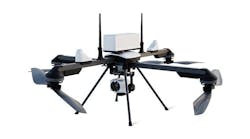Driver-less drones could offer Michigan businesses a faster and more affordable avenue for delivery in the not-so-distant future.
The state recently awarded a $150,000 grant to MightyFly, a California-based drone company, to perform autonomous cargo delivery flight demonstrations in Alpena in 2024. MightyFly has begun talks with potential business partners with its eyes on expanding into Michigan next year.
“What the market is in need of nowadays is same-day delivery that is affordable,” said Manal Habib, the company’s CEO. “Once we perform the demonstrations, we are going to extend to customers in Michigan and work with them to start solving some of their problems in logistics and pretty much enabling them to have this convenient, same-day delivery access they’ve been dreaming about.”
The company’s latest drone model — Centro — is an autonomous, hybrid-electric cargo aircraft that can carry up to 100 pounds of cargo, with an estimated cruise speed of 150 mph and a range of 600 miles. It can reportedly carry up to 212 small packages, and only needs the space of two parking spaces to land.
Not only can it fly itself, but it can load, balance itself, and unload packages on its own as well. If a business has a conveyor belt at its destination, it could even place the cargo on the belt.
Habib said her company set out to find a solution to the high cost of expedited delivery. Ground delivery can be affordable at about $100 per package, but it can be slow. Same-day options are quicker, but can cost around $400 per package.
That’s where autonomous flight comes into play. By getting rid of the driver and increasing fuel efficiency, MightyFly says its cost reduction can be gigantic and allow it to eventually charge closer to $50 per package for same-day delivery.
“We’re going to make same-day more affordable than next day,” Habib said.
MightyFly got its start in 2019 and developed its first aircraft in 2021. Last year, it added Centro, its second aircraft, which has since undergone more than 100 autonomous flights. A third aircraft is in the works which would double the size of Centro’s cargo bay.
Habib said her team has worked with the Federal Aviation Administration ( FAA) since day one to make sure their aircrafts follow general aviation standards. Their drones have been given special airworthiness certification from the FAA for long-range flight, meaning they can fly up to 5,000 feet in altitude and can fly over some suburban and low-populated areas.
“The way we work with the FAA is like a crawl, walk, then run approach,” she said. “We see the demonstrations in Alpena as the walking stage.”
MightyFly envisions working with the auto industry in Michigan, as well as medical, manufacturing, retail, logistics, and chemical industries. The state’s demos have not yet been scheduled, but Habib expects them to take place mid-2024.
The $150,000 grant came from the Michigan Office of Future Mobility and Electrification (MOFME), through its Michigan Mobility Funding Platform. It’s a program that seeks to facilitate mobility initiates and drive private investment and job growth while finding new ways to move people and goods from point A to point B by air, land or water.
Charlie Tyson, technology activations director for MOFME, said there’s been a lot of traction in Michigan around aerial mobility and low-altitude drones that can move small packages a short distance. But few companies are working in the area of transporting larger cargo over greater distances like MightyFly.
Beyond funding, Tyson’s office wants to work with companies like MightyFly to facilitate connections to venture capital firms locally, universities for hiring, and other partners to help them grow in Michigan.
Before autonomous delivery drones becomes a reality in Michigan, the state will likely need to build upon its existing infrastructure. The Department of Transportation’s aeronautics recently commissioned a feasibility study to consider the creation of “beyond visual line of sight” drone operation corridors around the state.
The study looked at existing airspace, air traffic infrastructure, and ground infrastructure required to ensure operational safety of commercial drone skyway, as well as potential economic impacts, applicable state and local zoning restrictions, environmental factors, and travel impacts. Its findings are expected to be made public later this summer.
Tyson said those drone corridors would likely include things like radar communication technology, a flight control center, and routes with low-ground risk like along train tracks or shorelines, or through rural communities.
“It’s critical for us to work with communities to understand and explain the benefits of drones and make sure all of the safety boxes are checked and that’s an ongoing process,” he said. “We also understand communities and folks don’t want to have hundreds of drones flying over their house all of the time so again that’s why the routes are critical.”
Read more on MLive:
Michigan State sued over redacting details about 1,400-acre mega site
A Northern Michigan highway could be in for a facelift in 2025
Months after MSU shooting, a lawmaker wants to allow guns on campuses
Popular weight loss drug gets new warning
©2023 Advance Local Media LLC. Visit mlive.com. Distributed by Tribune Content Agency, LLC.

